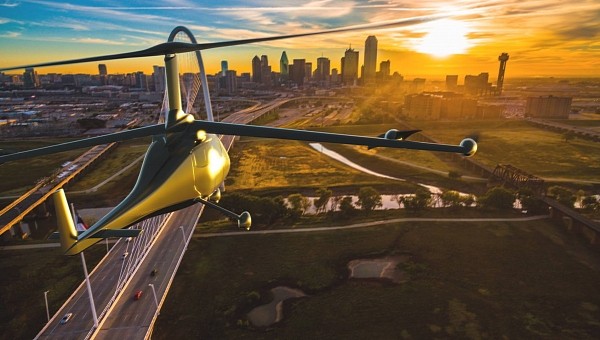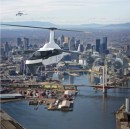If you think that designing and developing an eVTOL (electric vertical take-off and landing) from scratch is hard, you’d probably be surprised to know that it’s just the beginning of an even harder road ahead. That’s the road to certification, one that takes a lot of time and effort, and which requires the ability to adapt quickly. It’s undeniable that air taxis are closer than ever, but there are still a few regulatory hurdles to tackle.
Jaunt Air Mobility introduced its flagship eVTOL, Jaunt Journey, two years ago, as a silent and ultra-efficient electric aircraft. What made it stand out among all the other aircraft designs on the AAM (Advanced Air Mobility) market is the SRC (Slowed-Rotor Compound) technology.
What this does is allow the eVTOL to take off and land vertically, but cruise like an airplane, while also reducing rotor speed in cruise mode. The results are significantly-lower noise levels, and a smooth flight experience. As Jaunt’s CEO, Kaydon Stanzione, famously put it, it guarantees that “you will never spill your martini when riding in a Jaunt Journey.”
But the FAA (Federal Aviation Administration) is not impressed by such fancy promises. What it requires are hard facts and figures. This year, the certification requirements for eVTOLs got even tougher. For example, they now include the powered-lift category, for certifying both aircraft and future pilots.
Powered-lift aircraft are those that can take off and land vertically and switch to low-speed flight. Jaunt claims that this recent addition does not impact its trajectory, thanks to the SRC technology that already addresses it.
Plus, it also makes Journey a safer eVTOL, enabling it to land either by autorotation or through controlled gliding. This means that even if the aircraft might suffer a total loss of propulsion, the pilot would still have complete control all throughout the descent.
Safety is the main priority for eVTOL certification, according to FAA Administrator Billy Nolen, who also stated that commercial operations could be expected by the beginning of 2025.
In the meantime, Jaunt continues to work on certification for Journey. Last year, the company merged with the AIRO Group, and this year it secured an important number of orders for its future eVTOL. Journey is expected to start operating in places such as Quebec and South Korea. It’s also working with airport operator Avports on integrating its future air vehicle within the existing aviation infrastructure.
Set up in Dallas, Texas, but with its manufacturing carried out in Montreal, Canada, Jaunt has developed three concepts so far, all based on the idea of bringing VTOL capabilities to fixed-wing aircraft. But there’s still a long road ahead of the Jaunt Journey, aiming for full certification no earlier than 2027.
What this does is allow the eVTOL to take off and land vertically, but cruise like an airplane, while also reducing rotor speed in cruise mode. The results are significantly-lower noise levels, and a smooth flight experience. As Jaunt’s CEO, Kaydon Stanzione, famously put it, it guarantees that “you will never spill your martini when riding in a Jaunt Journey.”
But the FAA (Federal Aviation Administration) is not impressed by such fancy promises. What it requires are hard facts and figures. This year, the certification requirements for eVTOLs got even tougher. For example, they now include the powered-lift category, for certifying both aircraft and future pilots.
Powered-lift aircraft are those that can take off and land vertically and switch to low-speed flight. Jaunt claims that this recent addition does not impact its trajectory, thanks to the SRC technology that already addresses it.
Plus, it also makes Journey a safer eVTOL, enabling it to land either by autorotation or through controlled gliding. This means that even if the aircraft might suffer a total loss of propulsion, the pilot would still have complete control all throughout the descent.
Safety is the main priority for eVTOL certification, according to FAA Administrator Billy Nolen, who also stated that commercial operations could be expected by the beginning of 2025.
In the meantime, Jaunt continues to work on certification for Journey. Last year, the company merged with the AIRO Group, and this year it secured an important number of orders for its future eVTOL. Journey is expected to start operating in places such as Quebec and South Korea. It’s also working with airport operator Avports on integrating its future air vehicle within the existing aviation infrastructure.
Set up in Dallas, Texas, but with its manufacturing carried out in Montreal, Canada, Jaunt has developed three concepts so far, all based on the idea of bringing VTOL capabilities to fixed-wing aircraft. But there’s still a long road ahead of the Jaunt Journey, aiming for full certification no earlier than 2027.






